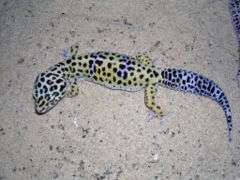Eublepharis
| Eublepharis | |
|---|---|
 | |
| Eublepharis macularius | |
| Scientific classification | |
| Kingdom: | Animalia |
| Phylum: | Chordata |
| Class: | Reptilia |
| Order: | Squamata |
| Infraorder: | Gekkota |
| Family: | Eublepharidae |
| Genus: | Eublepharis Gray, 1827 |
| Species | |
|
Eublepharis angramainyu | |
The genus Eublepharis was first described by the British zoologist John Edward Gray in 1827. The etymology of their name is 'eu' = Good (=true) |'blephar' = Eyelid, and all have fully functional eyelids. Members of this genus are found in eastern and southwestern Asia where they are found in arid and semiarid habitats. These geckos are sturdily built. Their tail is shorter than their snout-vent length and their body is covered with numerous wart-like bumps. The toes do not have adhesive lamellae. Eublepharis are crepuscular or nocturnal ground-dwellers. Included in this group is the popular pet gecko: the Leopard Gecko.
Five species are currently recognized.
Classification of genus Eublepharis
- Iraqi Eyelid Gecko, Eublepharis angramainyu
- West Indian Leopard Gecko,Eublepharis fuscus
- East Indian Leopard Gecko, Eublepharis hardwickii
- Common Leopard Gecko, Eublepharis macularius
- Afghan leopard gecko, Eublepharis macularius afghanicus
- Eublepharis macularius fasciolatus
- Eublepharis macularius macularius
- Eublepharis macularius montanus
- Eublepharis macularius smithi
- Turkmenistan Eyelid Gecko, Eublepharis turcmenicus
The members of the Goniurosaurus kuroiwae superspecies were formerly considered members of the genus Eublepharis, and were described under the synonyms Eublepharis orientalis Okada, 1936; Eublepharis kuroiwae; Eublepharis kuroiwae kuroiwae; Eublepharis kuroiwae splendens Nakamura & Uano, 1959; Eublepharis splendens, Eublepharis kuroiwae Maki, 1931, and others.